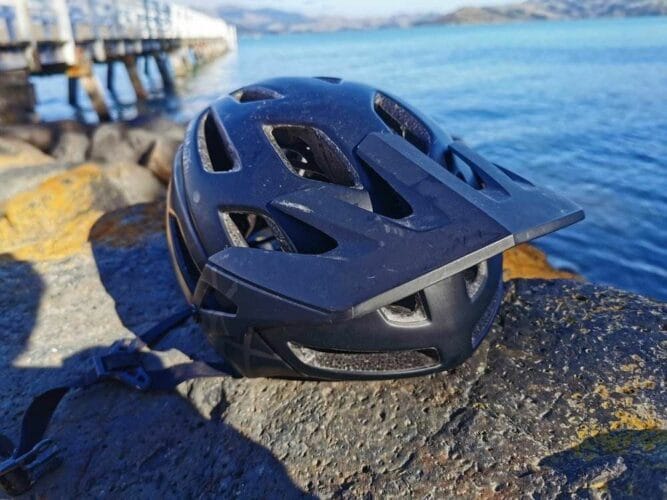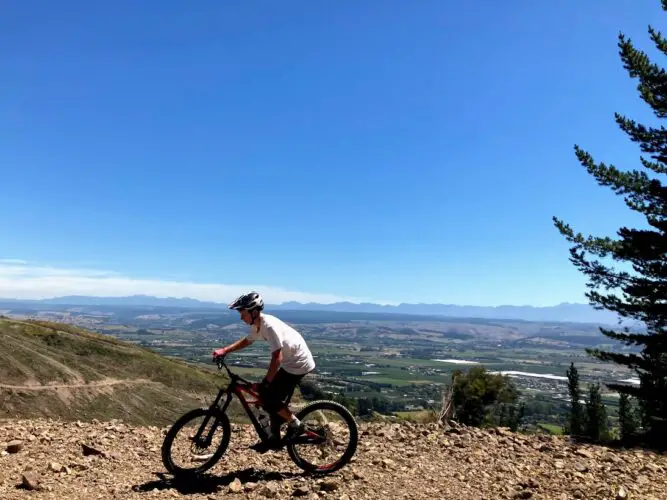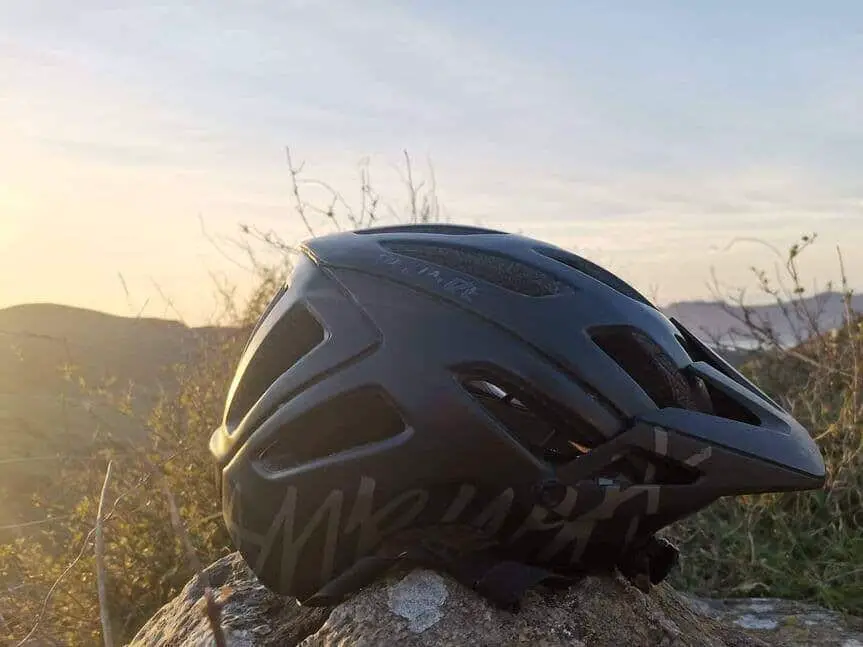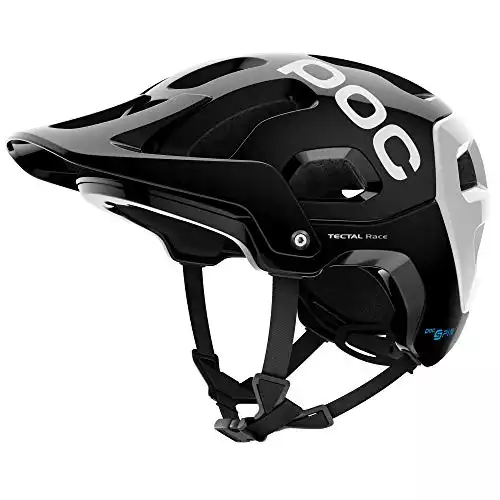These are two very impressive, top-tier helmets. For open face helmets, you can’t do much better than these two lids. But which is better when considering the Specialized Ambush vs. POC Tectal SPIN? We will look into the specifics of both helmets to see which suits you and your riding needs!
Both helmets are very good in terms of performance. There isn’t a lot we can complain about with either helmet, but we will look into the differences to see which you would likely prefer.
Specialized Ambush Comp MIPS w ANGi

Pros
- MIPS SL
- Well Ventilated
- Goggle compatible
Cons
- The Straps are not fully adjustable around the ears
- Could be more comfortable
Specialized has been creating exceptional products for a long time. They are very rider-focused, ensuring they design for the rider, rather than the budget. They look at what makes the helmet comfortable and look at the things the rider wants while adding extra to keep the consumer always surprised!
The Specialized Ambush Comp with ANGi is no exception!
POC Tectal Race SPIN Mini Review
One of the best helmets you can buy in terms of performance, ventilation, and comfort for shredding the trails.
Pros
- SPIN technology
- Eyewear compatible
- Very comfortable
- Well Ventilated
- Looks good
Cons
- Visor a bit fiddly
The POC Tectal Race SPIN is a premium product designed by the premium apparel company POC. The Tectal effectively vents like a cross country helmet with the protection of an enduro helmet. It really is a no expense spared type of helmet. It also looks really good and feels amazing on.
Construction Comparison
Shell
The Specialized Ambush is constructed of in-mold EPS foam and polycarbonate shell. This contributes to making it lighter, stronger and more durable. Across it, the Aramid bridge creates a very strong structure and holds the helmet together in a crash, so you don’t get a split helmet leaving your head unprotected. The Tectal is much the same with in-mold EPS foam, polycarbonate outer shell, and an Aramid bridge.
Both have great coverage around the rear of the head and over the temples. This extended foam that covers the back gives the helmets more of an enduro kind of coverage. And the more coverage you have, the more you are protecting the back of the head from getting hurt.
Vents and Liner
The layout of the vents in the Ambush means that you can see right through the helmet if you hold it at a certain angle. Specialized calls it 4th-dimensional ventilation. It is supposed to not only have superior ventilation, but also aerodynamics and be lighter.
The Mindset 360 adjustment system is built into the shell of the Ambush, rather than the plastic liner that you typically see on helmets. This allows it to tighten right around the head, rather than just squeezing the back of the helmet to make it fit.
Adjustment
The visor on Ambush has 16 notches for the visor to sit. I find this incredibly useful as you can always find a spot for it to sit that either blocks the sun or gets right out the way. Goggles can easily be stored beneath the visor if you ride with goggles too!
The Tectal has a slightly different system, where you set the visor to where you want, then tighten the dial. This means there are effectively hundreds of positions, but it is also much more fiddly. I’d prefer to be able to just move it, and it snaps into place like the Ambush, rather than play around with unscrewing and screwing it into position.
Design Comparison
Both the Specialized Ambush and the POC Tectal SPIN have very rounded shells. This is a feature that is often overlooked, but a rounded helmet will help the head move over objects easier without causing great discomfort to the rider’s neck and head.
In terms of looks, I believe the Tectal wins here. There is something about the shape and the two-tone shell that looks very professional. Obviously, this is just personal preference though!
Safety Comparison
Anti-Rotational Systems
Specialized have equipped the Ambush with MIPS SL, which is supposedly the lightest and best ventilated MIPS system available. The system, which is exclusive to Specialized helmets, doesn’t have a plastic liner as most MIPS systems do. Instead, it uses padding that is able to slide relative to the helmet using Velcro tabs and rubber bands. This acts to reduce the impact of angular crashes.
The Tectal has the SPIN system, which is reasonably similar, using pads that move with the head relative to the helmet. The pads are filled with medical-grade silicone, which mimics cerebral fluid, so less energy is transferred to the rider’s head in both linear and angular crashes.
Location Devices
Both helmets have a sensor system to help locate the rider if they crash. The Ambush has an ANGi sensor, which sends an alert to your phone if it senses a crash. If you are okay, you can stop the notification, but if not, it will send an alert to your designated contact.
The Tectal has a Recco reflector, which helps locators find the helmet, and hence the rider, in a search and rescue type situation. Both ANGi and Recco are very handy technologies to have if you often ride solo. It gives you just a bit more confidence that emergency services will be able to find you if something does happen.
Other
The shell of both helmets extend down behind the head to keep the back of the head well protected. The Ambush actually has some of the greatest extended rear coverage seen on a trail helmet, and the Tectal SPIN isn’t far behind. You can rest assured your skull is well protected in a tumble down a hill!
Comfort Comparison
I have been riding with the Ambush for around 2 years now and have had little wear and tear on the helmet. It isn’t as comfortable as the POC Tectal, or many other helmets, for that matter. I didn’t really notice it at first, but after wearing the Giro Montaro or the Troy Lee Designs A1, it just doesn’t compare!
The Tectal has superior comfort. The padding is soft, and it sits well on your head. The pads, which make up the SPIN technology, are filled with silicone, which is comfortable and doesn’t wear out over time.
Both helmets are very adjustable. Both have the ability to change the positioning of the helmet on your head, shifting the helmet closer to your forehead or closer towards the back of your neck. Not many helmets have this feature, but it just means it fits more head shapes comfortably.
Weight Comparison
There is no doubt about it, the Ambush is light- at 330 g, it’s almost pushing road helmet territory. It is incredible considering the amount of protection and coverage the helmet has. It is down to the lightweight Aramid bridge, and then the extra effort has been put into making everything else light too. Even the straps are lightweight!
The Tectal is lagging slightly behind at 370 g, with an extra 40 g (approximately) for you to lug around. By no means is it a heavy helmet, however, but if weight is a crucial deciding factor for you, then the Ambush is easily the better choice.
Ventilation Comparison
I also couldn’t complain about the ventilation on the Ambush. It has 20 vents and the previously mentioned Mindset 360. Even on the hottest days, I haven’t felt the urge to take off the helmet, which is more I can say about even some road helmets I wear!
The Tectal also isn’t bad at getting rid of the excess heat. With 15 large intake and exhaust vents, the vents act as scoops to send cool air through the helmet and out the back. It effectively vents like a cross country helmet, but with the shape and protection of an enduro helmet.
Additional Features
With the purchase of ANGi technology, you get free access to Specialized Ride Premium App too. The ANGi sensor system on the Ambush actually connects to Strava to give real-time tracking for those needing to know about your whereabouts.
The Ambush is easily compatible with goggles and glasses, and you can stow goggles beneath the visor if required. The chin straps are fixed below the ears but reasonably low, so they fit over the majority of ears and reduce fiddling.

The Tectal has a stretchy rubber band on the rear of the helmet to hold goggles in place. This we’ve found is generally unnecessary. Unless you have slippy goggles, they tend to stick in place anyway. Even so, it’s a nice addition, so you don’t need to be worried about losing the googles. Or you could even hold some snacks in there if you needed?!
The pads are removable and hence washable. (Check out how to clean a helmet here). The straps are adjustable under the chin as well as beneath the ears. While some find this a little fiddly, others find it is super handy being able to suit the straps to their ear positioning.
Goggles and glasses are certainly compatible with the Tectal. They fit especially well if you use some of POC’s eyewear too!
Conclusion
It is a tough decision when comparing the Specialized Ambush vs. POC Tectal SPIN
The purpose of a helmet is to keep your head safe, and both these helmets do that exceptionally well. However, before you do come off, you want a comfortable and well-ventilated lid with plenty of features.
The Ambush is a better ventilated helmet, has a simpler visor system, and is much lighter. This helmet has been an excellent helmet for the past two years, and the ventilation is a big factor for me, so this would be my choice.
However, if you value comfort and style over ventilation and weight, I would say the POC Tectal Race SPIN was the better way to go.
Again, this is entirely up to you and your preferences in a helmet. This article has simply outlined strengths and weaknesses of each helmet, but both are exceptional helmets and I seriously doubt you will be disappointed either way.

For some more comparisons, have a look at Bell Super DH vs. Bell Super 3R, Giro 4Forty vs. Giro Chronicle, or check out the Giro Source review.

